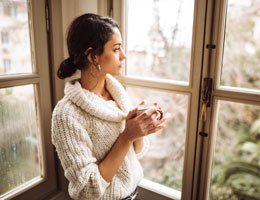
Winter days can be cool and short, and sometimes, keeping your spirits up can be hard work. But for some people, it feels impossible.
These people may have seasonal affective disorder (SAD), a recurring form of depression that begins in the late fall and continues through winter. SAD is more than just "winter blues"—it can be a disabling illness that interferes with everyday activities.
Every winter, SAD affects about 5% of people in the United States, according to the American Psychiatric Association (APA).
The dark season
The shorter days of winter, when people are exposed to less and less sunlight, seem to be the source of SAD. The lack of sunlight may affect the body's production of melatonin, a hormone that brings on sleep and helps set a person's "internal clock."
According to the National Institute of Mental Health (NIMH), people with SAD may also have trouble regulating serotonin, a chemical involved in mood.
Because the disorder is related to latitude, SAD is more common in the northern United States than in the southern states, and January and February are the most difficult months. But some people have a rare form of SAD that's set off in the summer.
Symptoms of SAD can range from mild to severe. According to the APA, symptoms may include:
- Feeling sad or depressed.
- Losing interest in activities you usually enjoy.
- A change in appetite, especially a craving for sweet or starchy foods. Weight gain may result.
- Feeling worthless or guilty.
- Fatigue and a tendency to oversleep.
- Feeling restless—or feeling slow.
- Difficulty concentrating and making decisions.
- Thoughts of death or suicide.
SAD affects men and women of all ages, but women and young adults are most likely to develop the disorder, according to the APA.
Many people with SAD have a family history of depression.
Turning on the light
Most people with SAD feel back to normal each spring. But that's a long time to wait, and there are treatments that can help sooner.
According to the APA, some people may feel better just by spending time outside or sitting near a window during the day.
Light therapy is an effective option. During light therapy, a person sits in front of a special artificial light box. The box emits a bright white light, and a lens filters out dangerous ultraviolet radiation.
Light therapy is usually done every day first thing in the morning for about 30 to 45 minutes. Treatment usually starts in the early fall and continues throughout the winter.
Other treatment options include psychotherapy and antidepressants, according to the APA and NIMH.
If you think you might have SAD, see your doctor. It's important to get an accurate diagnosis and get started on treatment.
And if you have thoughts of suicide, you should see a doctor or go to an emergency department immediately. You can also call or text 988 to reach the 988 Suicide & Crisis Lifeline.
Reviewed 3/12/2024
Sources
- American Psychiatric Association. "Seasonal Affective Disorder (SAD)." https://www.psychiatry.org/patients-families/seasonal-affective-disorder
- National Institute of Mental Health. "Seasonal Affective Disorder." https://www.nimh.nih.gov/health/publications/seasonal-affective-disorder